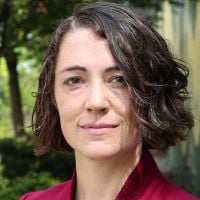If you are up on your women in science trivia, you are likely familiar with Ada Lovelace. Lovelace is credited with writing the world’s first computer code. Remarkably, she created code way back in 1843 for a machine that wasn’t even fully functioning yet. 1843! The “Analytical Machine” was built by her colleague Charles Babbage and Lovelace described at length how the machine would work in all its algebraic detail.

English mathematician and writer Ada Lovelace juggled child-rearing and scientific study in the 19th century just as many scientists do today. Photo: Wikipedia
What I have found even more remarkable is that Lovelace conquered this feat when she had a lot more going on. In the midst of her pursuit of mathematics, Lovelace also bore three children. During the years she had children, she had to step away from her studies. This was true especially after the birth of her second child, when she fell ill for several months. This hiatus from her mathematics work no doubt took a toll on her scientific progress. And it’s worth noting that Lovelace was affluent and thus, likely had more resources to help her manage children and a career than would have been available to most women at the time.
Can scientists take a hiatus to care for family?
As I return from four months of maternity leave this month, I am even more appreciative of the tremendous challenge of doing science while meeting demanding family commitments. I was lucky to get the time off to care for my newborn, but many others aren’t so fortunate today. And even if new parents do get time off from work, scientific institutions aren’t necessarily forgiving of this time away from the lab bench.
Scientists in academia and elsewhere are judged by productivity. A year or several without publications can have implications for one’s standing in the scientific community. Assistant professors are “on the clock” before they get tenure, and must demonstrate their productivity in their first years on the job. Having children during this crucial time period can limit the amount of work scientists—especially mothers—get done. Today, science and engineering departments in American universities are still predominantly male, despite roughly equal numbers of STEM PhDs awarded to female and male students. While the reasons women choose to leave academia are complex and varied, the pressure to get tenure during the times women would want to start a family is often cited.
Improving family leave for scientists
While on my maternity leave, I met another new mom who was a research scientist at a nearby university. She talked about all of the work she had to do even though she was officially on leave—incorporating peer-review edits, reviewing papers for others, reacting to emails, etc. She said if she’d known about the constant time demands of science, she might of have chosen a different career path.
We need to do better. The challenges that Ada Lovelace faced trying to raise children and be a scientist in the 19th century are disturbingly similar to the challenges faced by parents today, especially for women who tend to bare the greatest parenting burdens.
What can we do? We need to create a culture that is not only tolerant of scientists’ who want a work-life balance, but helps them to thrive. Better leave policies at both public and private institutions would be a great start. When academic scientists are up for tenure or applying for jobs, awards, and fellowships, selection committees should take into account any children had during that time period. This type of consideration, along with other family friendly policies, is more customary in many European countries. The US needs to catch up.
This month, the Royal Society launched the #AndAScientist campaign to highlight scientists who are also parents or caregivers. With a goal to create a more inclusive environment in the sciences, the campaign highlights stories of scientists who have time-consuming family commitments outside of work and also continue to produce science. Campaigns like this can help shine a light on the issue and hopefully change the conversation. But we also need policies to follow.
In the meantime, and as I settle back into work life, I’m especially aware that I’m now a mother and a scientist.
